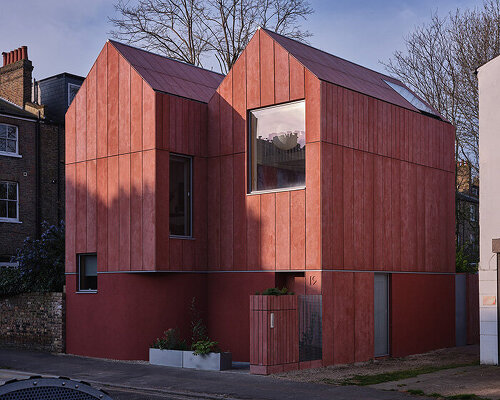Graeme Williamson Reconsiders Domestic Space in London
The newly completed Twin House stands on a compact urban plot in London, designed by Graeme Williamson Architects as a residence for the architect’s blended family. The project approaches the idea of home as a flexible framework, both spatially and symbolically, expressed through its distinctive twin-gabled silhouette clad in red cement board.
The house’s form responds to the duality of two family units combining under one roof. From each street-facing elevation, the paired rooflines register as familiar domestic profiles held in subtle tension. This clear geometry also supports a sculptural reading of the volume, allowing the building to engage differently with each surrounding context.
images © Leon Chew
an Adaptable, upside-down layout
Inside, architect Graeme Williamson’s Twin House adopts an upside-down layout, which places the main living, working, and dining spaces on the first floor. The elevated position benefits from long views across Hackney and improved daylight access. Bedrooms and bathrooms are arranged on the ground level and in the basement, creating separation between communal life and private retreat.
With this configuration, the architect anticipates the evolving needs of the household. As the couple’s children approach adulthood, the lower floor bedrooms can be closed off, leaving a one-bedroom dwelling across the upper levels. The planning strategy allows the house to potentially adapt over time without requiring significant structural changes.
Graeme Williamson Architects designs Twin House as a home for a blended family
wrapped in an all-red facade
A continuous red cement board wraps the Twin House’s roof and facade in a single, unbroken surface. The cladding, containing a high proportion of wood fiber, was chosen both for its low-carbon impact and its capacity to unify the massing. Its matte texture subtly shifts in appearance as light moves across the facades throughout the day.
Interiors incorporate bespoke cement tiles designed by Melanie Mues, the architect’s partner and a graphic designer. Laid in fragmented patterns, the tiles reference the geometry of the twin roofs while introducing a tactile counterpoint to the smooth planes of concrete and plaster.
the project features a twin-gabled profile clad entirely in red cement board
Apertures are distributed to admit daylight at calibrated times. Morning light enters the kitchen and dining zone through low east-facing openings, while evening sun filters into the living spaces through west-oriented windows. Carefully placed glazing also mitigates overheating and ensures privacy without sacrificing views toward the cityscape.
The design of each elevation follows a deliberate balance of exposure and enclosure, producing facades that engage with the shifting rhythms of the street and the sky. This measured approach to daylight was a central driver of the project’s form and fenestration.
an ‘upside-down layout’ places living spaces upstairs and bedrooms below
the configuration allows the house to adapt as children move out over time
large apertures are positioned to bring in daylight and maintain privacy
each facade responds to different urban conditions with a sculptural approach
inside the house, bespoke cement tiles reference the geometric form of the roofs
project info:
name: Twin House
architect: Graeme Williamson Architects | @graemewilliamsonarchitects
location: Stoke Newington, Hackney, London, England
tile design: Melanie Mues
photography: © Leon Chew | @leon.chew
The post monochromatic facade wraps graeme williamson’s dual-gabled ‘twin house’ in london appeared first on designboom | architecture & design magazine.

